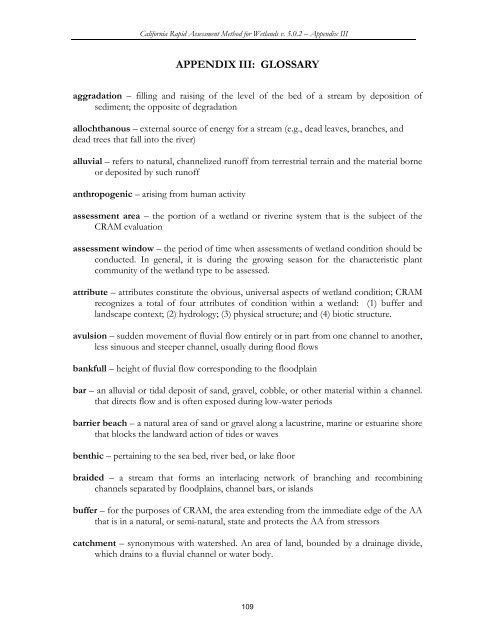(CRAM) For Wetlands User's Manual Version 5.0.2
(CRAM) For Wetlands User's Manual Version 5.0.2
(CRAM) For Wetlands User's Manual Version 5.0.2
You also want an ePaper? Increase the reach of your titles
YUMPU automatically turns print PDFs into web optimized ePapers that Google loves.
California Rapid Assessment Method for <strong>Wetlands</strong> v. <strong>5.0.2</strong> – Appendix III<br />
APPENDIX III: GLOSSARY<br />
aggradation – filling and raising of the level of the bed of a stream by deposition of<br />
sediment; the opposite of degradation<br />
allochthanous – external source of energy for a stream (e.g., dead leaves, branches, and<br />
dead trees that fall into the river)<br />
alluvial – refers to natural, channelized runoff from terrestrial terrain and the material borne<br />
or deposited by such runoff<br />
anthropogenic – arising from human activity<br />
assessment area – the portion of a wetland or riverine system that is the subject of the<br />
<strong>CRAM</strong> evaluation<br />
assessment window – the period of time when assessments of wetland condition should be<br />
conducted. In general, it is during the growing season for the characteristic plant<br />
community of the wetland type to be assessed.<br />
attribute – attributes constitute the obvious, universal aspects of wetland condition; <strong>CRAM</strong><br />
recognizes a total of four attributes of condition within a wetland: (1) buffer and<br />
landscape context; (2) hydrology; (3) physical structure; and (4) biotic structure.<br />
avulsion – sudden movement of fluvial flow entirely or in part from one channel to another,<br />
less sinuous and steeper channel, usually during flood flows<br />
bankfull – height of fluvial flow corresponding to the floodplain<br />
bar – an alluvial or tidal deposit of sand, gravel, cobble, or other material within a channel.<br />
that directs flow and is often exposed during low-water periods<br />
barrier beach – a natural area of sand or gravel along a lacustrine, marine or estuarine shore<br />
that blocks the landward action of tides or waves<br />
benthic – pertaining to the sea bed, river bed, or lake floor<br />
braided – a stream that forms an interlacing network of branching and recombining<br />
channels separated by floodplains, channel bars, or islands<br />
buffer – for the purposes of <strong>CRAM</strong>, the area extending from the immediate edge of the AA<br />
that is in a natural, or semi-natural, state and protects the AA from stressors<br />
catchment – synonymous with watershed. An area of land, bounded by a drainage divide,<br />
which drains to a fluvial channel or water body.<br />
109















